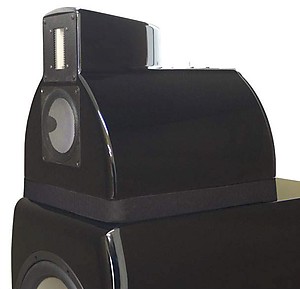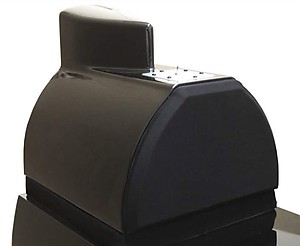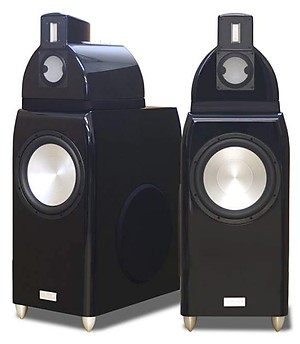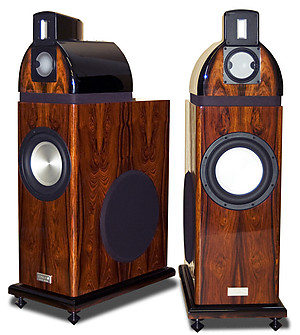The Salk Signature Soundscape
Salk Signature Sound have recently announced completion of the long-awaited SoundScape loudspeaker. This new loudspeaker is available in two base versions, one with a 10″ woofer and one with a 12″ woofer. John Reekie talks to Jim Salk and Dennis Murphy, from Salk Signature Sound, about their new flagship loudspeaker.
JR – Jim, Dennis: perhaps we could start by you outlining your respective roles in Salk Signature Sound.
Dennis – Jim is usually the source of ideas on what types of speakers will meet a particular market need and will have the most appeal. For example, Jim decided at the outset to emphasize ribbon tweeters and custom crafted cabinetry. We collaborate pretty evenly on the choice of drivers, and then I design a crossover that I think will produce the most accurate sound. The great advantage I have over crossover designers for most commercial speakers is that Jim never imposes any design or cost constraints. I have free reign to do whatever is necessary to get the job done.
 Jim – Dennis and I have a sort of informal relationship. When designing a speaker, we generally talk about the goals of the project and exchange ideas about potential drivers and other design elements. Once an agreement is reached, we go about the process of modeling and designing a prototype cabinet that Dennis can use to develop the crossover. (Those who have visited him report that his home is filled with ugly MDF prototype cabinets… sorry, Dennis!) Sometimes the design works as well or better than we anticipated. Other times, things simply don’t come together.
Jim – Dennis and I have a sort of informal relationship. When designing a speaker, we generally talk about the goals of the project and exchange ideas about potential drivers and other design elements. Once an agreement is reached, we go about the process of modeling and designing a prototype cabinet that Dennis can use to develop the crossover. (Those who have visited him report that his home is filled with ugly MDF prototype cabinets… sorry, Dennis!) Sometimes the design works as well or better than we anticipated. Other times, things simply don’t come together.
We are very fussy about what we put our name on. So if a design does not work out to our satisfaction, we either scrap the idea or re-work it. Many of these potential designs never see the light of day. That is the nature of speaker design.
I have learned over the years to trust Dennis’ judgment. If, after working on a crossover, he has reservations about the design, we scrap it or go back to the drawing board. If he tells me he is happy with the results, we feel confident enough to forge ahead and develop all the fixtures and templates required to put the design into production. I am very confident that when Dennis says a design is “ready,” we will have another winner on our hands. He is that talented.
JR – The SoundScape is now Salk’s top-of-the-range speaker. Why did you decide to develop this speaker?
Dennis – I’m sure Jim can explain the genesis better than I, but in general we were trying to improve on the HT3. I was most interested in seeing whether we could provide a more expansive, deeper sound stage without sacrificing detail, focus, and neutrality – and without making the speakers as difficult to place in the room as some completely open-back designs. I spent a year trying out various approaches, and had the most luck with a kind of transmission line opening for the midrange in an otherwise conventional cabinet. That provided enough rear wave information to add depth and spaciousness to the sound stage without causing cancellation problems with the front wave. The added advantage is that the line can be left free of any absorbent material for maximum rear wave effect, or stuffed with various densities of polyfill to the owner’s taste. It can even be closed entirely with a magnetic rear cover. I also asked Jim to design a cabinet with an absolute minimum of baffle area around the RAAL tweeter, which I hoped would add to the spaciousness of the sound.
Then Jim went to work on the cabinet design, after which we experimented with a number of top-of-the-line midrange drivers. That added almost another year to the development process, but I’m confident that it was worth the wait. I had no role in the choice of woofer, or in the passive radiator design. That was the brainchild of Jeff Bagby.
 Jim – About a year after completing the Veracity HT3 design (which historically has been our most popular speaker), we began to ask ourselves what we could possibly do to top it. That design exceeded our expectations, so it was a difficult act to follow. If what we developed would not represent a significant step forward, there would be no sense in introducing it. So we knew it would be a significant challenge.
Jim – About a year after completing the Veracity HT3 design (which historically has been our most popular speaker), we began to ask ourselves what we could possibly do to top it. That design exceeded our expectations, so it was a difficult act to follow. If what we developed would not represent a significant step forward, there would be no sense in introducing it. So we knew it would be a significant challenge.
We wanted a speaker that was flat to at least 20 Hz (the 12″ version) and had a significantly deeper and wider sound stage than the HT3. It had to be very accurate and very detailed. And it had to impart no sonic signature of its own, literally disappearing and allowing the music to take center stage.
We were not looking for a speaker that “sounded great,” since that would imply it was somehow adding character of its own. In that sense, there should be nothing remarkable about the speaker itself other than the fact that it let the music shine through… nothing more… nothing less.
During the design process, I was often asked why we would consider introducing a higher-priced speaker in the middle of a recession. My answer was that I didn’t really care how many we sold. This was simply a challenge we could not pass up. And if we never sold a pair, I would at least have the speakers of my dreams.
From the outset, we made a pledge that no decision would be made on the basis of cost. That did not mean we would use the most expensive drivers in the world, only that we would use the best drivers in the world for this particular application. And we would not make any compromises in terms of cabinet design to keep production costs to a minimum. Every decision made during the process was based on a simple question: What decision would result in the best speaker we were capable of producing?
In the end, nothing about this speaker was inexpensive. But the results certainly justify the costs, since the design does indeed take sound reproduction to a whole new level.
JR – Are you expecting to sell many?
Jim – I have no idea how many pairs we will eventually produce, but it is frankly not a concern. We set out to develop a world-class speaker that could compete with any speaker at any price. In that regard, we feel we have met our goals. If others like what we have done as much as we do, I’m sure it will be a very successful model.
JR – Can readers order one now?
Jim – Yes.
JR – Tell us about the drivers – are they a “cost-no-object” choice?
 Jim – Yes. No decision was ever made on the basis of cost. That does not mean the drivers were necessarily the most expensive. We simply purchased all of the candidates we could identify, and even had some designed just for this project. In the end, we took the final prospects and built pairs of finished prototypes to compare. After extensive listening, there was no doubt which drivers performed the best.
Jim – Yes. No decision was ever made on the basis of cost. That does not mean the drivers were necessarily the most expensive. We simply purchased all of the candidates we could identify, and even had some designed just for this project. In the end, we took the final prospects and built pairs of finished prototypes to compare. After extensive listening, there was no doubt which drivers performed the best.
The same was true of the cabinet design. For example, we built both transmission line woofer cabinets and ported cabinets before selecting the horizontally-opposed dual passive-radiator design. The same was true for the upper cabinet for the midrange and tweeter. It is very complicated to build, but significantly out-performed all of the other models we built and tested.
Rather than describing this as a “cost-no-object” project, I would describe it as a “quality is the only object” project. No compromises were allowed in the development process.
Dennis – There were no cost constraints for the drivers. We simply wanted whatever would produce the best sound. The tweeter was easy – both Jim and I love ribbon tweeters, and the RAAL is the best available. It has the most extended, effortless highs I have heard, and it’s also extremely rugged so I could cross to the midrange at a relatively low frequency (about 1900 Hz), which lets the midrange handle only the frequencies it’s best at. My only demand on the woofer was that it be able to operate smoothly at its high end, so that it could be crossed seamlessly to the midrange in the region of 250 – 350 Hz.
The midrange proved the most difficult selection. I tried out just about every high-end unit out there, but most had limitations – such as inadequate sensitivity – or even design flaws that we couldn’t tolerate in any speaker, certainly not in one this expensive. It finally came down to the little Accuton mid and a new and larger unit from a different manufacturer. I designed crossovers for both, and even though they measured almost identically in terms of frequency response, the Accuton consistently sounded more open and detailed when we did instant comparisons with an A-B switching preamp that a local electrical engineer designed for me.
JR – Tell us about the cabinet – what key challenges did you face? What is new about this cabinet for Salk Signature Sound?
Jim – There were a number of challenges with the design. We knew we wanted to separate the woofer section from the midrange/tweeter section. Early on, we decided we wanted no baffle at all around the tweeter. Of course, you have to mount it in something. So we wanted only what was necessary and nothing more. Finally, the midrange was a line with an open back. Its size was determined by the requirements for the design.
So we ended up with a large woofer section (box), a relatively small midrange cabinet (box) and a minimalistic tweeter cabinet (box). These stacked boxes were not very attractive to say the least!
One of our associates, Mike Vettraino, then took these requirements and started modeling them in CAD, resulting in the shapes of the final pieces. We think he did a great job considering the obstacles placed in his way by the demands of the design.
As with the driver selection, no compromises were made for aesthetic reasons. The speakers look the way they do because that is the way they had to look in order to sound the way they do.
JR – And the crossover – Dennis, did you learn anything new in the process of designing this speaker?
Dennis – My job was made easier by the extremely smooth response of the drivers we chose. But the quasi open-back midrange construction did prove a challenge. I had to find which range of frequencies sounded best with this arrangement, and the midrange voicing had to be perfect in order to preserve a sense of focus and clarity while still providing adequate rear wave ambience. As Jim will testify, it took a while to get it right. Because the woofer is such a rare blend of deep bass capability and a smooth upper end, I was able to use second-order acoustic crossover slopes for the cross between the woofer and midrange. I prefer to use that topology wherever possible, because I think it provides the best driver integration, particularly in the lower midrange.
JR – Are there any compromises that you had to make with the design of this speaker, that you wish you hadn’t?
Dennis – The only “compromise” we made was deciding to stick with a passive crossover between the woofer and midrange, rather than actively driving the woofer with its own amplifier. Jim thought (and I agree) that buyers of Salk speakers would prefer the simplicity of a passive design and the freedom it provides for users to choose their own amplifiers.
But there is no reason why a partially or even completely active version of the Soundscapes could not be designed if there were sufficient market interest.
Jim – It would have been nice to have slightly higher sensitivity. But Hoffman’s law simply gets in the way. The only ways you can produce bass that is this extended is to use a low sensitivity driver or multiple drivers to raise the sensitivity. Since multiple drivers introduce their own set of complications that negatively impact sound quality, we decided to keep the design simple and clean. In the end, watts are cheap and we simply didn’t want to compromise the sound quality. We figured that people who would be purchasing these speakers would have no trouble providing the requisite power to drive them properly.
JR – And so… how do they sound?
 Dennis – The sound depends much more on the recording than room location or electronics. On some studio recordings with no natural ambience, it will sound very similar, though still superior, to other Salk speakers. I’ve frequently auditioned prototypes for guests with my magic comparison preamp using the Song Towers as a reference, and there have been times when the main difference was in bass reach and clarity. But on a live recording or a studio recording with a real stage and skillful placement of mics, the difference can be dramatic. It literally sounds as if someone removed the rear wall and you were in the concert hall or other venue. And the effect doesn’t require a “head-in-a-vice” seating position. You can stand up and walk around the room and still experience an enveloping sound field and clear positioning of instruments and voices.
Dennis – The sound depends much more on the recording than room location or electronics. On some studio recordings with no natural ambience, it will sound very similar, though still superior, to other Salk speakers. I’ve frequently auditioned prototypes for guests with my magic comparison preamp using the Song Towers as a reference, and there have been times when the main difference was in bass reach and clarity. But on a live recording or a studio recording with a real stage and skillful placement of mics, the difference can be dramatic. It literally sounds as if someone removed the rear wall and you were in the concert hall or other venue. And the effect doesn’t require a “head-in-a-vice” seating position. You can stand up and walk around the room and still experience an enveloping sound field and clear positioning of instruments and voices.
Although I’m in no way responsible, the bass is a revelation both in term of reach and clarity of impact. I’ve literally knocked pictures off of the wall on my favorite organ cuts.
Jim – I had a friend over one night to hear the SoundScapes. Before I fired the system up, I said, “You know that tomorrow people will ask you for a report.”
“Yeah…so…,” he said.
To which I replied, “Well, the problem is you will be hard pressed to explain it to them. These speakers do not stand out in any way. So it will be difficult to point toward any specific performance attribute that might set them apart. All you will hear is the music…nothing more, nothing less. Once you hear them, you will understand. But it will be difficult to explain the experience to someone who has not.”
To me, that is the mark of a great design.
JR – Does they work better with specific room sizes, positioning, or amplification?
Jim – We had always been challenged with the bass response of the HT3 in the small rooms at Rocky Mountain Audiofest. These rear-ported speakers can overload a small room with bass. So when we first brought the SoundScape 12 prototypes to RMAF last year, I expected quite a challenge getting them set up properly.
We set everything up and prepared to start tuning the room. But we were amazed that they sounded better than the HT3 did right from the start. We made some adjustments and listened a little more. Then made some more adjustments. In the end, they sounded great no matter where we put them. The only conclusion I could draw is that the horizontally-opposed dual passive radiators pressurize the room more evenly than is possible with a ported design.
At home, I even tried moving them to within 5″ of the rear wall. While the bass was slightly more pronounced, it seemed far from objectionable. In fact, I could easily see someone actually preferring the bass reinforcement. So I don’t think these speakers are particularly problematic in small rooms or when positioned in a less-than-ideal situation. They are certainly easier to work with in that regard than just about any rear-ported 3-way I have worked with in the past.
On the amplification side, I have run these with a 100 watt amp and the sound was certainly acceptable. But I would not recommend it. At very low frequencies, you are moving a lot of air and that requires power. A speaker like this deserves to be fed with high-quality source gear and plenty of watts to provide adequate headroom.
Needless to say, with a speaker this detailed and accurate, you will be able to hear any upstream change in program material and source gear. The better signal they are fed, the better they will sound.
JR – This project has been a long time in the making – 4 years I believe? Did you ever wonder if you just weren’t going to get to see it finished?
Dennis – Yes.
Jim – There were indeed times when it seemed like things were never going to come together. We agonized over details and, just when we thought we had things sorted out, another issue would surface. But despite the challenges and disappointments along the way, we tried to remain focused on the goal at hand and maintain a positive attitude. We were not in any special hurry and simply kept moving toward the finish line.
I’m sure we pushed Dennis to the edge on more than a few occasions along the way. For this, I have to apologize. But, to his credit, he hung in there with us and should be very proud of what he was able to accomplish. We can never thank him enough for his efforts.
JR – I’m sure you’re both very pleased with the outcome, and justifiably so I expect. Looking back on the project now, what do you think is the one thing that will stick in your mind forever?
Jim – I can’t say there is one particular thing that stands out. But I recall when we had finished the HT3, Dennis commented something to the effect that there are many great 2-way speakers in the world, but few truly great 3-way designs. They are so difficult to design properly, great designs are few and far between. In this case, we were trying to set new standards of performance for a 3-way. We feel we have succeeded beyond even our optimistic goals. I just never imagined it would be quite this challenging… or rewarding.
Dennis – Other than the usual moments when something didn’t work at all like you hoped, I think it was the time I played a Bach organ prelude recorded in a vast German cathedral. I’ve never heard a living room sound quite like that before.
Basic technical specifications
Frequency response: 18 Hz to 20,000 Hz ± 1dB for SS12, 19 Hz to 20,000 Hz ± 1 dB for SS10.
Sensitivity: 87.5 dB for SS12, 85 dB for SS10.
Crossover: 2nd order Linkwitz-Riley acoustic slopes for woofer-mid, 4th order Linkwitz-Riley for mid-tweeter.
Weight: SS10: Heavy. SS12: Heavier.
Manufacturer’s website
http://www.salksound.com/




Looks really cool to me, although my girlfriend thought the midrange enclosure looks like our BBQ Smoker from the side.
The woofer looks a lot my my kids expensive car stereo woofers made by the old TC Sounds in California! This is a very good thing if it is a TC Sounds woofer in there.
I would love to hear them one day.
They look that for a reason . . physics. I take it you understand that and whose girlfriend does? I want one. It’s about what the microphone(s) captured in the first place, what is imbedded into our recordings, by those engineers and producers whose idea it was to avail us to that as best they can. Bless em.
Right you are–the woofers are very similar to the old TC sound versions. Both the 10″ and 12″ version have been reworked slightly to lower harmonic distortion.